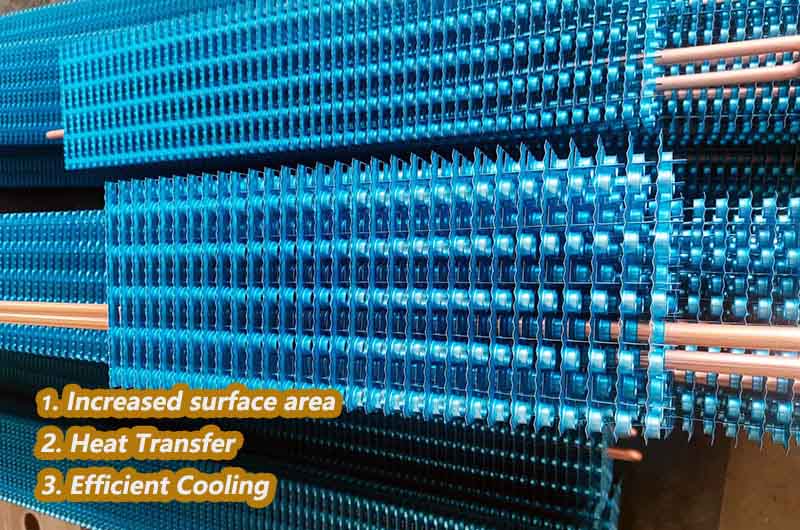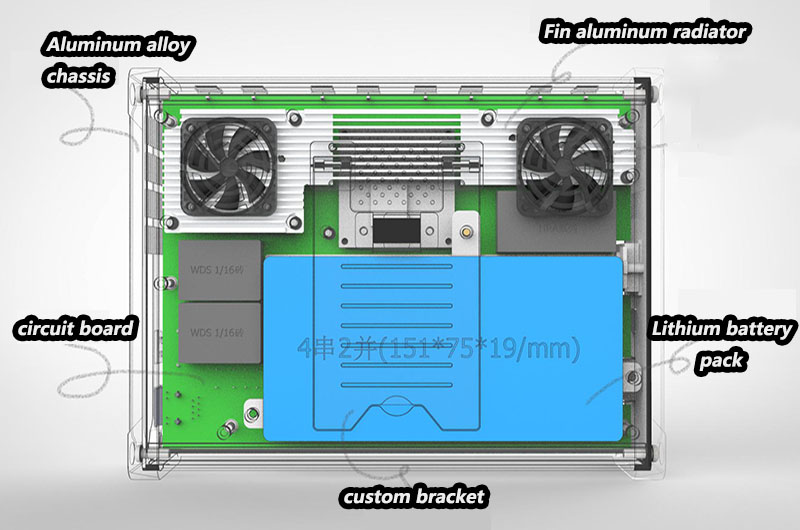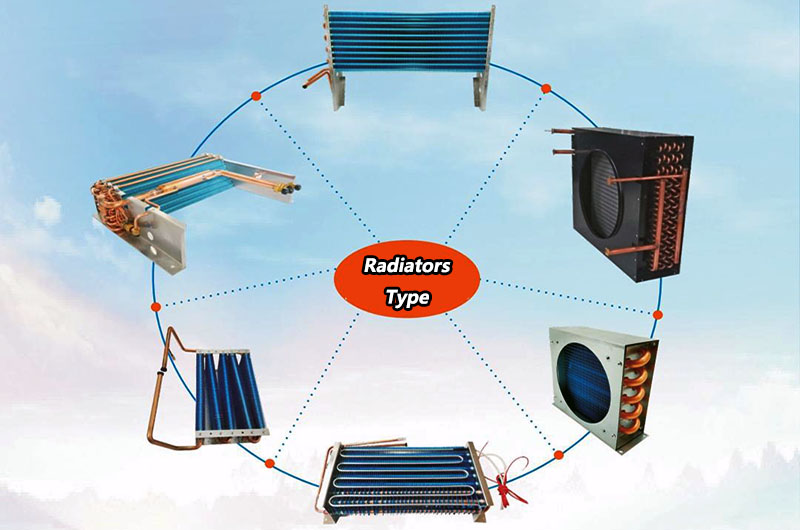- Understand Radiators
- The Crucial Role of Aluminum Fins for Radiators
- Typical Radiators Aluminum Fin Stock
- Radiators Aluminum Fin Stock Alloy and Specifications
- Advantages of Radiators Aluminum Fins
- Radiators Aluminum Fin Stock Manufacturing Process
- Radiators Aluminum Fin Stock Applications
- Aluminum Fin Stock for Radiators Notes
- Conclusion
Radiators play a key role in maintaining optimal temperatures in systems ranging from car engines to electronic devices. Among the key components of the radiator, the fin material is crucial.
Understand Radiators
What is a radiator?
A radiator is a heat exchanger that transfers thermal energy from one medium to another. It usually consists of a network of pipes or channels in which a heat-carrying fluid circulates. As this fluid absorbs heat from the cooling system, it flows through the radiator and dissipates the heat to the surrounding environment.
What does a radiator do?
The main function of the radiator is to dissipate excess heat generated by the system, prevent overheating and maintain optimal operating temperature. This mechanism is critical in preventing damage to engines, electronics, and other heat-sensitive components, helping to increase the overall efficiency and reliability of systems with integrated radiators.
Common radiator applications in daily life
- A. Car cooling system
- B. Heating, Ventilation, and Air Conditioning (HVAC) Systems
- C. Electronic equipment
- D. Industrial applications
- E. Refrigeration and air conditioning units
- F. Oil cooling system

The Crucial Role of Aluminum Fins for Radiators
- Increased surface area: Aluminum fins are thin, light and have a large surface area. By connecting these fins to pipes or channels through which coolant (usually liquid or air) flows, the total surface area available for heat exchange is significantly increased. This increased surface area allows for more efficient heat transfer from the coolant to the surrounding air.
- Heat Transfer: Fins provide a larger contact area for heat transfer. As hot coolant circulates through pipes or channels, heat is conducted to the fins. The large surface area of the heat sink helps transfer heat to the surrounding air, thus promoting effective cooling.
- Convection: The design of the fins also promotes convection, which is the process of heat transfer through the movement of fluid (liquid or gas). As air flows over the fins, it absorbs heat from the fins, removing thermal energy from the system.
- Efficient Cooling: Aluminum is a good conductor of heat and its use in fins allows for efficient thermal conductivity. This means heat can be conducted quickly through the fins, promoting efficient cooling of the fluid circulating through the radiator.
- LIGHTWEIGHT AND DURABLE: Aluminum was chosen for the fins because it is lightweight and corrosion-resistant. This is especially important in automotive applications, where weight considerations are critical and they are often exposed to a variety of environmental conditions.
- Corrosion Resistance: Aluminum has good corrosion resistance, which is critical for parts exposed to coolants and other liquids. This helps extend the life of the radiator and ensures long-term, reliable performance.
Typical Radiators Aluminum Fin Stock
1100 Radiators Aluminum Fin Stock
Alloy 1100 is a commercially pure aluminum alloy with excellent corrosion resistance. It is often used in applications where high strength is not a critical factor.
Application: General-purpose radiator fins, where corrosion resistance is a primary concern.
3003 Radiators Aluminum Fin Stock
Alloy 3003 is a widely used alloy for radiator fins due to its good formability, corrosion resistance, and thermal conductivity. It is suitable for various heat exchange applications.
Application: Automotive radiator fins, heat exchangers, and other applications where formability, corrosion resistance, and moderate strength are required.

6061 Radiators Aluminum Fin Stock
Alloy 6061 is heat-treatable and offers good mechanical properties. It is used in applications where a balance of strength, formability, and corrosion resistance is needed.
Application: High-performance radiator fins in applications where higher strength and thermal conductivity are required.
5052 Radiators Aluminum Fin Stock
Alloy 5052 is known for its excellent corrosion resistance and is often used in marine applications. It may be suitable for industrial radiators exposed to corrosive environments.
Application: Marine or industrial radiator fins requiring good corrosion resistance.
4343/3003/4343 Radiators Aluminum Fin Stock
This is a specific clad aluminum alloy often used in automotive radiator applications. The 4343 alloy provides good corrosion resistance, and the cladding process enhances brazing properties.
Radiators Aluminum Fin Stock Alloy and Specifications
One of the most widely used alloys is aluminum alloy 3003.
Composition: Mainly composed of aluminum, with a small amount of manganese added (approximately 1-1.5%).
Properties: This alloy is known for its excellent formability, corrosion resistance and moderate strength. It is suitable for a variety of applications including heat exchangers and radiator fins.
Specifications and Notes
- Thickness: Fin thickness can vary based on specific heat sink design and application requirements.
- Surface Treatment: Some radiator fins may be surface treated or coated to increase corrosion resistance or improve heat transfer.
- Fins per inch (FPI): The number of fins per inch is an important consideration. It refers to the density of fins on the surface of the heat exchanger and affects the overall heat transfer efficiency.
- Shape and Design: Options include flat fins, louvered fins or serrated fins, each offering different performance characteristics.
It is important to note that although aluminum alloy 3003 is commonly used, other alloys with different compositions may be used based on specific performance and cost considerations. Some heat sinks may use alloy 6061 or alloy 1100, depending on the application and requirements.

Advantages of Radiators Aluminum Fins
A. High thermal conductivity
One of the main advantages of using aluminum fins in heat sinks is their excellent thermal conductivity. Aluminum conducts heat efficiently, promoting rapid dissipation of heat from the radiator fins into the surrounding air. This feature helps improve the overall efficiency of the radiator system, ensuring optimal temperature regulation in a variety of applications, including automotive cooling systems and electronic equipment.
B. Light and durable
Aluminum's lightweight properties are advantageous in applications where weight is a critical factor, such as the automotive industry. Using aluminum fins helps reduce the overall weight of the radiator, helping to improve the vehicle's fuel efficiency. In addition, aluminum's inherent corrosion resistance enhances the durability of the radiator system and extends its service life.
C. Formability and design flexibility
Aluminum's malleability and malleability allow for complex fin designs that maximize the surface area available for heat exchange. This formability is particularly valuable in space-constrained applications because manufacturers can tailor the fin blank to meet specific geometric requirements. Design flexibility enables the creation of efficient, compact radiator systems for different applications.
D. Cost-effective production
The cost-effectiveness of aluminum fin blank manufacturing plays a critical role in its widespread adoption. In particular, the extrusion process provides an efficient and economical way to produce large quantities of radiator fins of consistent quality. This cost advantage contributes to the overall affordability of aluminum-based radiator systems, making them the first choice across industries.
Radiators Aluminum Fin Stock Manufacturing Process
A. squeeze
The extrusion process is commonly used for the production of aluminum fins for heat sinks.
During the extrusion process, a heated billet of aluminum is forced through a die, forming a profile with the desired shape. This approach allows the fabrication of fins with varying thicknesses and complex patterns, maximizing surface area exposed to air for enhanced heat dissipation.
Extruded aluminum fins are known for their uniformity, precision and cost-effectiveness.
B. Roll bonding
Another method of manufacturing aluminum fin blanks is roll bonding.
The process involves bonding two or more layers of dissimilar metals together through the application of heat and pressure. In the case of heat sink fin stock, aluminum is typically bonded to a core material such as copper or steel to combine the thermal conductivity of aluminum with the strength of the core material. This allows the composite fin blank to exhibit superior performance characteristics.
Radiators Aluminum Fin Stock Applications
A. Car radiator
Car cooling systems rely heavily on efficient heat dissipation to maintain engine temperatures within an optimal range. Aluminum fins are the material of choice for automotive radiators due to their lightweight, corrosion resistance and excellent thermal conductivity. These features help improve engine performance, reduce fuel consumption and improve overall vehicle efficiency.

B. HVAC system
Heating, ventilation, and air conditioning (HVAC) systems use radiators to regulate indoor temperature. Aluminum fins are ideal for HVAC applications because they provide efficient heat exchange in a lightweight and corrosion-resistant package. The versatility of the design allows for the creation of compact and efficient radiator units for residential and commercial HVAC systems.
C. Electronic device cooling
The electronics industry relies on efficient thermal management to prevent overheating and ensure the reliability of electronic components. Aluminum fins are used in the production of heat sinks and heat sinks for electronic equipment ranging from computers to power electronics. Aluminum's lightweight properties are particularly beneficial for portable electronic devices where weight is a key consideration.
D. Industrial heat exchanger
Industrial processes often generate large amounts of heat, which must be efficiently dissipated to maintain equipment integrity. Aluminum fins are used in the manufacture of heat exchangers for industrial applications, achieving a balance of thermal performance, durability and cost-effectiveness. These heat exchangers are used in a variety of industries, including manufacturing, chemical processing, and power generation.
Aluminum Fin Stock for Radiators Notes
Thickness: The thickness of the fins is a key parameter that depends on the design requirements and cooling needs of the heat sink.
Fins per inch (FPI): The number of fins per inch affects heat transfer efficiency and is a design consideration.
Surface Treatment: Some radiator fins may be surface treated or coated to increase corrosion resistance or improve heat transfer.
Fin design: The shape and design of the fins, whether flat, louvered or another configuration, affects performance.
Conclusion
Aluminum fins have become the cornerstone of radiator design across industries, providing a winning combination of thermal efficiency, durability and cost-effectiveness.
From automotive cooling systems to HVAC units and electronics, aluminum's versatility makes it an indispensable material when seeking to dissipate heat efficiently.
As technology continues to advance, so will innovation in aluminum fins, ensuring heat sinks remain at the forefront of thermal management solutions for years to come.
